HLSC122 Report: Music Festival Drug Use, Testing, and Implications
VerifiedAdded on 2023/03/17
|8
|2001
|37
Report
AI Summary
This report critically analyzes the research by Day et al. (2018) on illicit drug use among music festival attendees, examining the impact of drug testing services. The report provides a critical appraisal of the research methodology, including authorship, research questions, design, methods, results, and limitations. The study found a high prevalence of drug use and support for drug testing services among attendees. The report also discusses the application of these findings to a case scenario involving Emily and her mother, considering enablers and barriers to the uptake of the research's recommendations. It highlights the limitations of the study, such as the use of a convenience sample and potential gender bias, emphasizing the need for caution when applying the findings. The report concludes by summarizing the key findings and their implications for public health interventions aimed at reducing drug-related harm at music festivals. The report aims to provide insights into the complex relationship between drug use, drug testing, and public health interventions, offering a comprehensive analysis of the research and its practical implications.
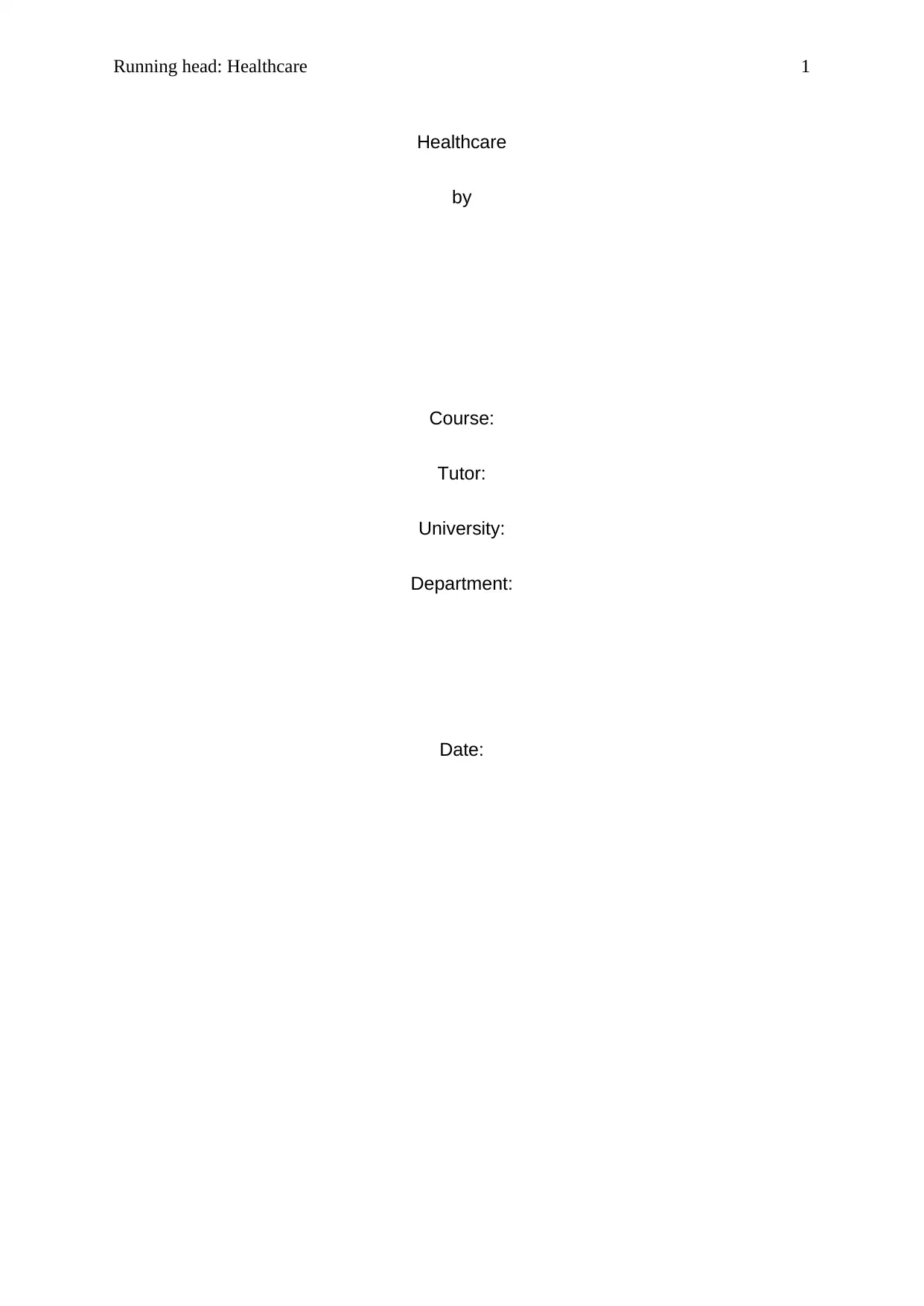
Running head: Healthcare 1
Healthcare
by
Course:
Tutor:
University:
Department:
Date:
Healthcare
by
Course:
Tutor:
University:
Department:
Date:
Paraphrase This Document
Need a fresh take? Get an instant paraphrase of this document with our AI Paraphraser
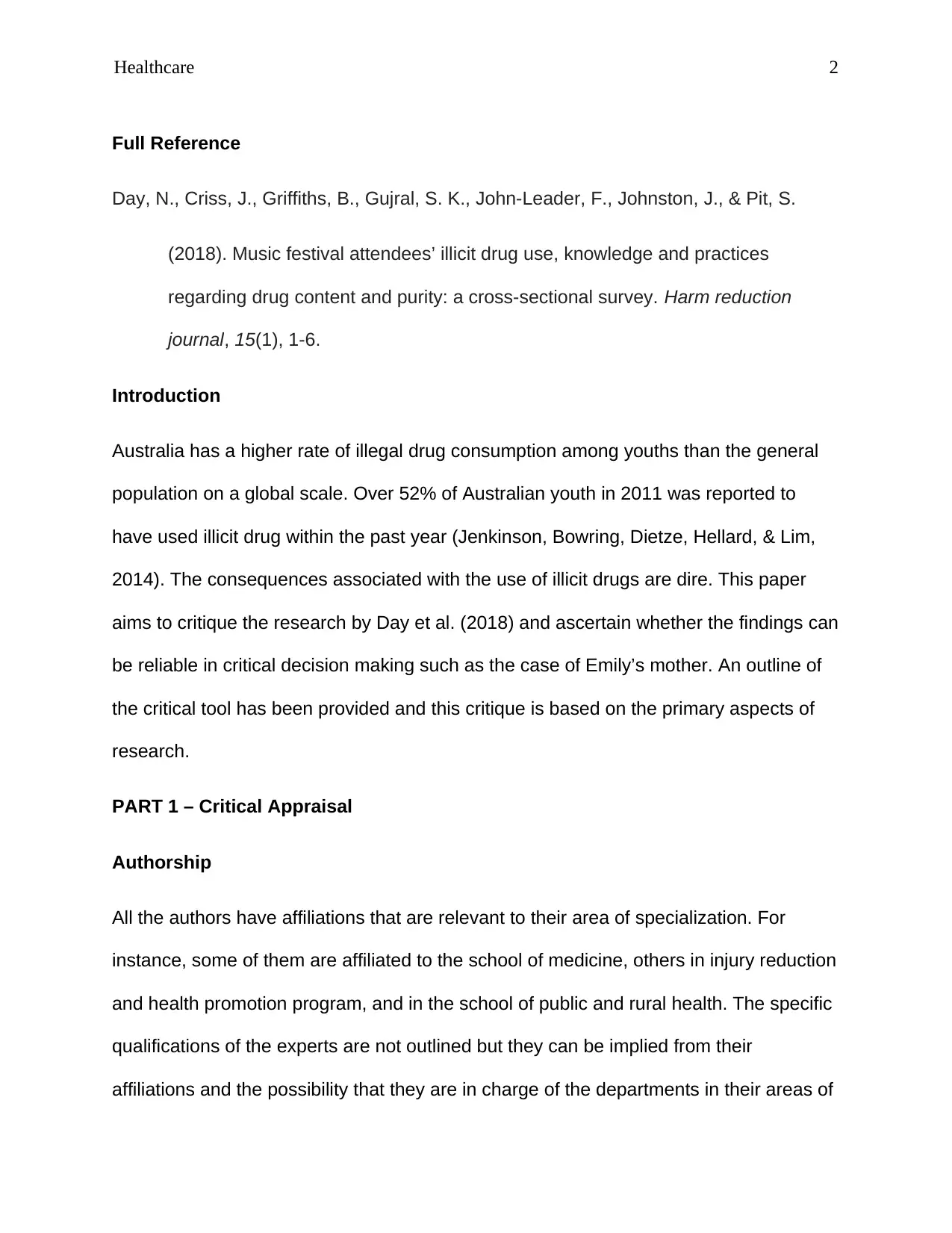
Healthcare 2
Full Reference
Day, N., Criss, J., Griffiths, B., Gujral, S. K., John-Leader, F., Johnston, J., & Pit, S.
(2018). Music festival attendees’ illicit drug use, knowledge and practices
regarding drug content and purity: a cross-sectional survey. Harm reduction
journal, 15(1), 1-6.
Introduction
Australia has a higher rate of illegal drug consumption among youths than the general
population on a global scale. Over 52% of Australian youth in 2011 was reported to
have used illicit drug within the past year (Jenkinson, Bowring, Dietze, Hellard, & Lim,
2014). The consequences associated with the use of illicit drugs are dire. This paper
aims to critique the research by Day et al. (2018) and ascertain whether the findings can
be reliable in critical decision making such as the case of Emily’s mother. An outline of
the critical tool has been provided and this critique is based on the primary aspects of
research.
PART 1 – Critical Appraisal
Authorship
All the authors have affiliations that are relevant to their area of specialization. For
instance, some of them are affiliated to the school of medicine, others in injury reduction
and health promotion program, and in the school of public and rural health. The specific
qualifications of the experts are not outlined but they can be implied from their
affiliations and the possibility that they are in charge of the departments in their areas of
Full Reference
Day, N., Criss, J., Griffiths, B., Gujral, S. K., John-Leader, F., Johnston, J., & Pit, S.
(2018). Music festival attendees’ illicit drug use, knowledge and practices
regarding drug content and purity: a cross-sectional survey. Harm reduction
journal, 15(1), 1-6.
Introduction
Australia has a higher rate of illegal drug consumption among youths than the general
population on a global scale. Over 52% of Australian youth in 2011 was reported to
have used illicit drug within the past year (Jenkinson, Bowring, Dietze, Hellard, & Lim,
2014). The consequences associated with the use of illicit drugs are dire. This paper
aims to critique the research by Day et al. (2018) and ascertain whether the findings can
be reliable in critical decision making such as the case of Emily’s mother. An outline of
the critical tool has been provided and this critique is based on the primary aspects of
research.
PART 1 – Critical Appraisal
Authorship
All the authors have affiliations that are relevant to their area of specialization. For
instance, some of them are affiliated to the school of medicine, others in injury reduction
and health promotion program, and in the school of public and rural health. The specific
qualifications of the experts are not outlined but they can be implied from their
affiliations and the possibility that they are in charge of the departments in their areas of
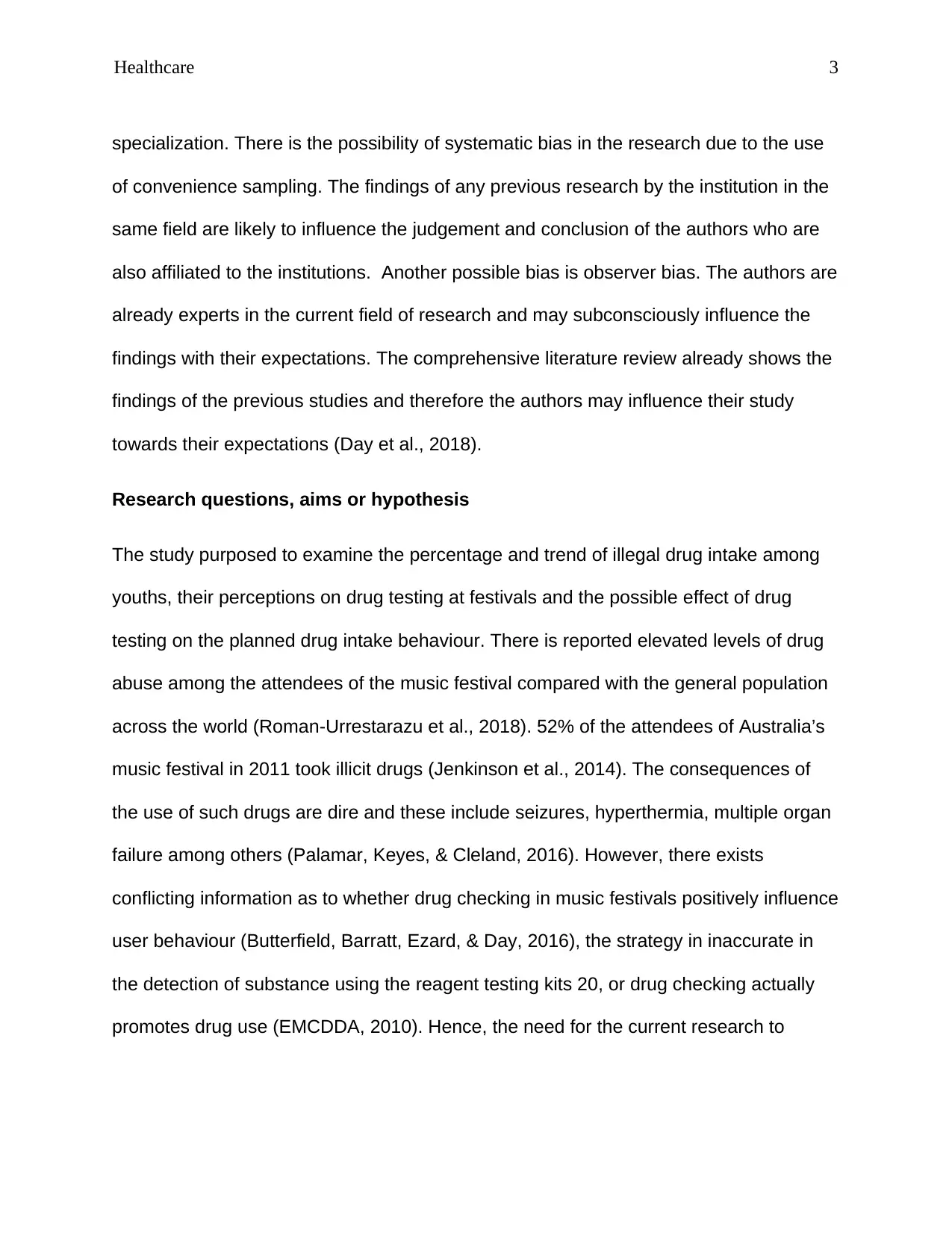
Healthcare 3
specialization. There is the possibility of systematic bias in the research due to the use
of convenience sampling. The findings of any previous research by the institution in the
same field are likely to influence the judgement and conclusion of the authors who are
also affiliated to the institutions. Another possible bias is observer bias. The authors are
already experts in the current field of research and may subconsciously influence the
findings with their expectations. The comprehensive literature review already shows the
findings of the previous studies and therefore the authors may influence their study
towards their expectations (Day et al., 2018).
Research questions, aims or hypothesis
The study purposed to examine the percentage and trend of illegal drug intake among
youths, their perceptions on drug testing at festivals and the possible effect of drug
testing on the planned drug intake behaviour. There is reported elevated levels of drug
abuse among the attendees of the music festival compared with the general population
across the world (Roman-Urrestarazu et al., 2018). 52% of the attendees of Australia’s
music festival in 2011 took illicit drugs (Jenkinson et al., 2014). The consequences of
the use of such drugs are dire and these include seizures, hyperthermia, multiple organ
failure among others (Palamar, Keyes, & Cleland, 2016). However, there exists
conflicting information as to whether drug checking in music festivals positively influence
user behaviour (Butterfield, Barratt, Ezard, & Day, 2016), the strategy in inaccurate in
the detection of substance using the reagent testing kits 20, or drug checking actually
promotes drug use (EMCDDA, 2010). Hence, the need for the current research to
specialization. There is the possibility of systematic bias in the research due to the use
of convenience sampling. The findings of any previous research by the institution in the
same field are likely to influence the judgement and conclusion of the authors who are
also affiliated to the institutions. Another possible bias is observer bias. The authors are
already experts in the current field of research and may subconsciously influence the
findings with their expectations. The comprehensive literature review already shows the
findings of the previous studies and therefore the authors may influence their study
towards their expectations (Day et al., 2018).
Research questions, aims or hypothesis
The study purposed to examine the percentage and trend of illegal drug intake among
youths, their perceptions on drug testing at festivals and the possible effect of drug
testing on the planned drug intake behaviour. There is reported elevated levels of drug
abuse among the attendees of the music festival compared with the general population
across the world (Roman-Urrestarazu et al., 2018). 52% of the attendees of Australia’s
music festival in 2011 took illicit drugs (Jenkinson et al., 2014). The consequences of
the use of such drugs are dire and these include seizures, hyperthermia, multiple organ
failure among others (Palamar, Keyes, & Cleland, 2016). However, there exists
conflicting information as to whether drug checking in music festivals positively influence
user behaviour (Butterfield, Barratt, Ezard, & Day, 2016), the strategy in inaccurate in
the detection of substance using the reagent testing kits 20, or drug checking actually
promotes drug use (EMCDDA, 2010). Hence, the need for the current research to
⊘ This is a preview!⊘
Do you want full access?
Subscribe today to unlock all pages.

Trusted by 1+ million students worldwide
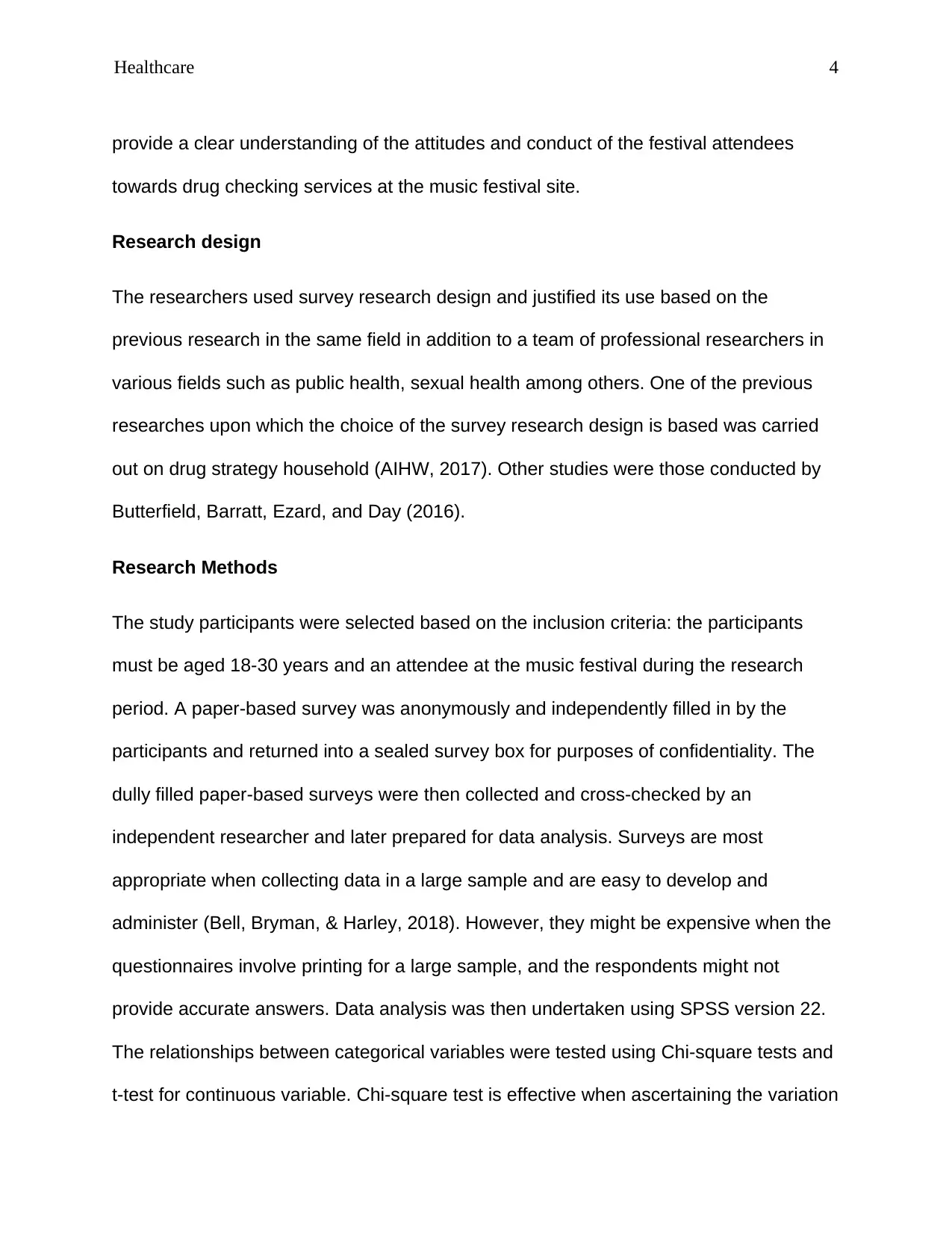
Healthcare 4
provide a clear understanding of the attitudes and conduct of the festival attendees
towards drug checking services at the music festival site.
Research design
The researchers used survey research design and justified its use based on the
previous research in the same field in addition to a team of professional researchers in
various fields such as public health, sexual health among others. One of the previous
researches upon which the choice of the survey research design is based was carried
out on drug strategy household (AIHW, 2017). Other studies were those conducted by
Butterfield, Barratt, Ezard, and Day (2016).
Research Methods
The study participants were selected based on the inclusion criteria: the participants
must be aged 18-30 years and an attendee at the music festival during the research
period. A paper-based survey was anonymously and independently filled in by the
participants and returned into a sealed survey box for purposes of confidentiality. The
dully filled paper-based surveys were then collected and cross-checked by an
independent researcher and later prepared for data analysis. Surveys are most
appropriate when collecting data in a large sample and are easy to develop and
administer (Bell, Bryman, & Harley, 2018). However, they might be expensive when the
questionnaires involve printing for a large sample, and the respondents might not
provide accurate answers. Data analysis was then undertaken using SPSS version 22.
The relationships between categorical variables were tested using Chi-square tests and
t-test for continuous variable. Chi-square test is effective when ascertaining the variation
provide a clear understanding of the attitudes and conduct of the festival attendees
towards drug checking services at the music festival site.
Research design
The researchers used survey research design and justified its use based on the
previous research in the same field in addition to a team of professional researchers in
various fields such as public health, sexual health among others. One of the previous
researches upon which the choice of the survey research design is based was carried
out on drug strategy household (AIHW, 2017). Other studies were those conducted by
Butterfield, Barratt, Ezard, and Day (2016).
Research Methods
The study participants were selected based on the inclusion criteria: the participants
must be aged 18-30 years and an attendee at the music festival during the research
period. A paper-based survey was anonymously and independently filled in by the
participants and returned into a sealed survey box for purposes of confidentiality. The
dully filled paper-based surveys were then collected and cross-checked by an
independent researcher and later prepared for data analysis. Surveys are most
appropriate when collecting data in a large sample and are easy to develop and
administer (Bell, Bryman, & Harley, 2018). However, they might be expensive when the
questionnaires involve printing for a large sample, and the respondents might not
provide accurate answers. Data analysis was then undertaken using SPSS version 22.
The relationships between categorical variables were tested using Chi-square tests and
t-test for continuous variable. Chi-square test is effective when ascertaining the variation
Paraphrase This Document
Need a fresh take? Get an instant paraphrase of this document with our AI Paraphraser
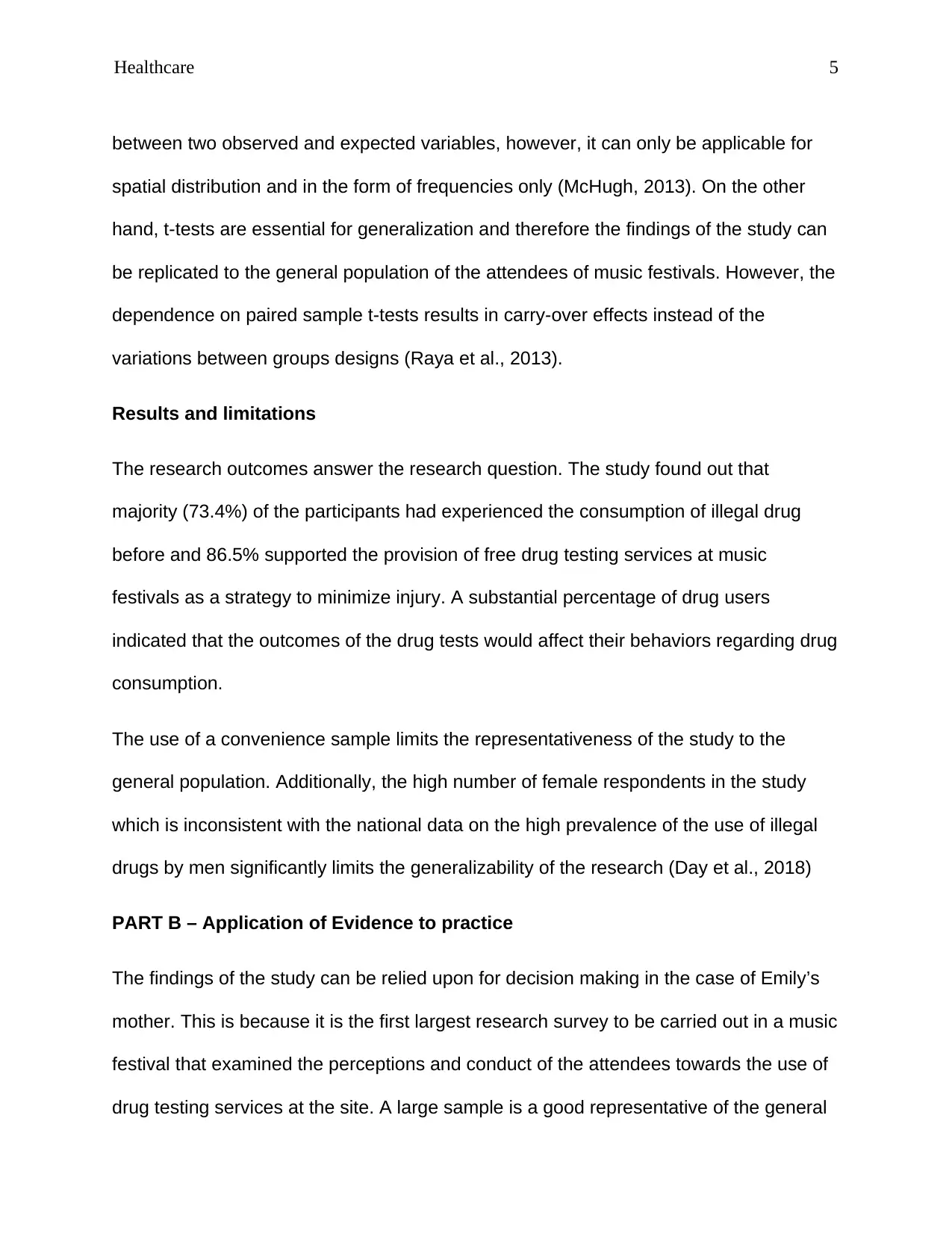
Healthcare 5
between two observed and expected variables, however, it can only be applicable for
spatial distribution and in the form of frequencies only (McHugh, 2013). On the other
hand, t-tests are essential for generalization and therefore the findings of the study can
be replicated to the general population of the attendees of music festivals. However, the
dependence on paired sample t-tests results in carry-over effects instead of the
variations between groups designs (Raya et al., 2013).
Results and limitations
The research outcomes answer the research question. The study found out that
majority (73.4%) of the participants had experienced the consumption of illegal drug
before and 86.5% supported the provision of free drug testing services at music
festivals as a strategy to minimize injury. A substantial percentage of drug users
indicated that the outcomes of the drug tests would affect their behaviors regarding drug
consumption.
The use of a convenience sample limits the representativeness of the study to the
general population. Additionally, the high number of female respondents in the study
which is inconsistent with the national data on the high prevalence of the use of illegal
drugs by men significantly limits the generalizability of the research (Day et al., 2018)
PART B – Application of Evidence to practice
The findings of the study can be relied upon for decision making in the case of Emily’s
mother. This is because it is the first largest research survey to be carried out in a music
festival that examined the perceptions and conduct of the attendees towards the use of
drug testing services at the site. A large sample is a good representative of the general
between two observed and expected variables, however, it can only be applicable for
spatial distribution and in the form of frequencies only (McHugh, 2013). On the other
hand, t-tests are essential for generalization and therefore the findings of the study can
be replicated to the general population of the attendees of music festivals. However, the
dependence on paired sample t-tests results in carry-over effects instead of the
variations between groups designs (Raya et al., 2013).
Results and limitations
The research outcomes answer the research question. The study found out that
majority (73.4%) of the participants had experienced the consumption of illegal drug
before and 86.5% supported the provision of free drug testing services at music
festivals as a strategy to minimize injury. A substantial percentage of drug users
indicated that the outcomes of the drug tests would affect their behaviors regarding drug
consumption.
The use of a convenience sample limits the representativeness of the study to the
general population. Additionally, the high number of female respondents in the study
which is inconsistent with the national data on the high prevalence of the use of illegal
drugs by men significantly limits the generalizability of the research (Day et al., 2018)
PART B – Application of Evidence to practice
The findings of the study can be relied upon for decision making in the case of Emily’s
mother. This is because it is the first largest research survey to be carried out in a music
festival that examined the perceptions and conduct of the attendees towards the use of
drug testing services at the site. A large sample is a good representative of the general
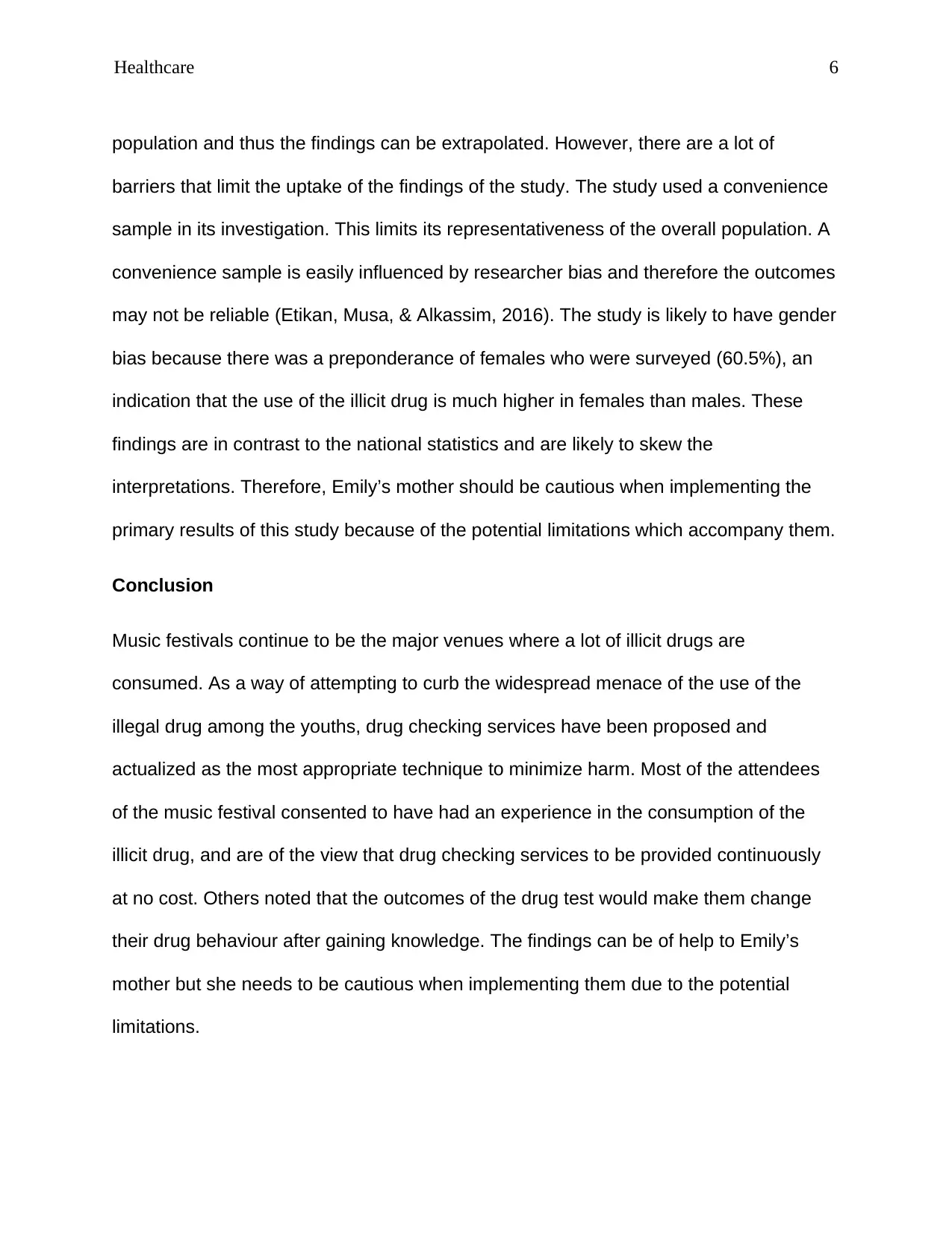
Healthcare 6
population and thus the findings can be extrapolated. However, there are a lot of
barriers that limit the uptake of the findings of the study. The study used a convenience
sample in its investigation. This limits its representativeness of the overall population. A
convenience sample is easily influenced by researcher bias and therefore the outcomes
may not be reliable (Etikan, Musa, & Alkassim, 2016). The study is likely to have gender
bias because there was a preponderance of females who were surveyed (60.5%), an
indication that the use of the illicit drug is much higher in females than males. These
findings are in contrast to the national statistics and are likely to skew the
interpretations. Therefore, Emily’s mother should be cautious when implementing the
primary results of this study because of the potential limitations which accompany them.
Conclusion
Music festivals continue to be the major venues where a lot of illicit drugs are
consumed. As a way of attempting to curb the widespread menace of the use of the
illegal drug among the youths, drug checking services have been proposed and
actualized as the most appropriate technique to minimize harm. Most of the attendees
of the music festival consented to have had an experience in the consumption of the
illicit drug, and are of the view that drug checking services to be provided continuously
at no cost. Others noted that the outcomes of the drug test would make them change
their drug behaviour after gaining knowledge. The findings can be of help to Emily’s
mother but she needs to be cautious when implementing them due to the potential
limitations.
population and thus the findings can be extrapolated. However, there are a lot of
barriers that limit the uptake of the findings of the study. The study used a convenience
sample in its investigation. This limits its representativeness of the overall population. A
convenience sample is easily influenced by researcher bias and therefore the outcomes
may not be reliable (Etikan, Musa, & Alkassim, 2016). The study is likely to have gender
bias because there was a preponderance of females who were surveyed (60.5%), an
indication that the use of the illicit drug is much higher in females than males. These
findings are in contrast to the national statistics and are likely to skew the
interpretations. Therefore, Emily’s mother should be cautious when implementing the
primary results of this study because of the potential limitations which accompany them.
Conclusion
Music festivals continue to be the major venues where a lot of illicit drugs are
consumed. As a way of attempting to curb the widespread menace of the use of the
illegal drug among the youths, drug checking services have been proposed and
actualized as the most appropriate technique to minimize harm. Most of the attendees
of the music festival consented to have had an experience in the consumption of the
illicit drug, and are of the view that drug checking services to be provided continuously
at no cost. Others noted that the outcomes of the drug test would make them change
their drug behaviour after gaining knowledge. The findings can be of help to Emily’s
mother but she needs to be cautious when implementing them due to the potential
limitations.
⊘ This is a preview!⊘
Do you want full access?
Subscribe today to unlock all pages.

Trusted by 1+ million students worldwide
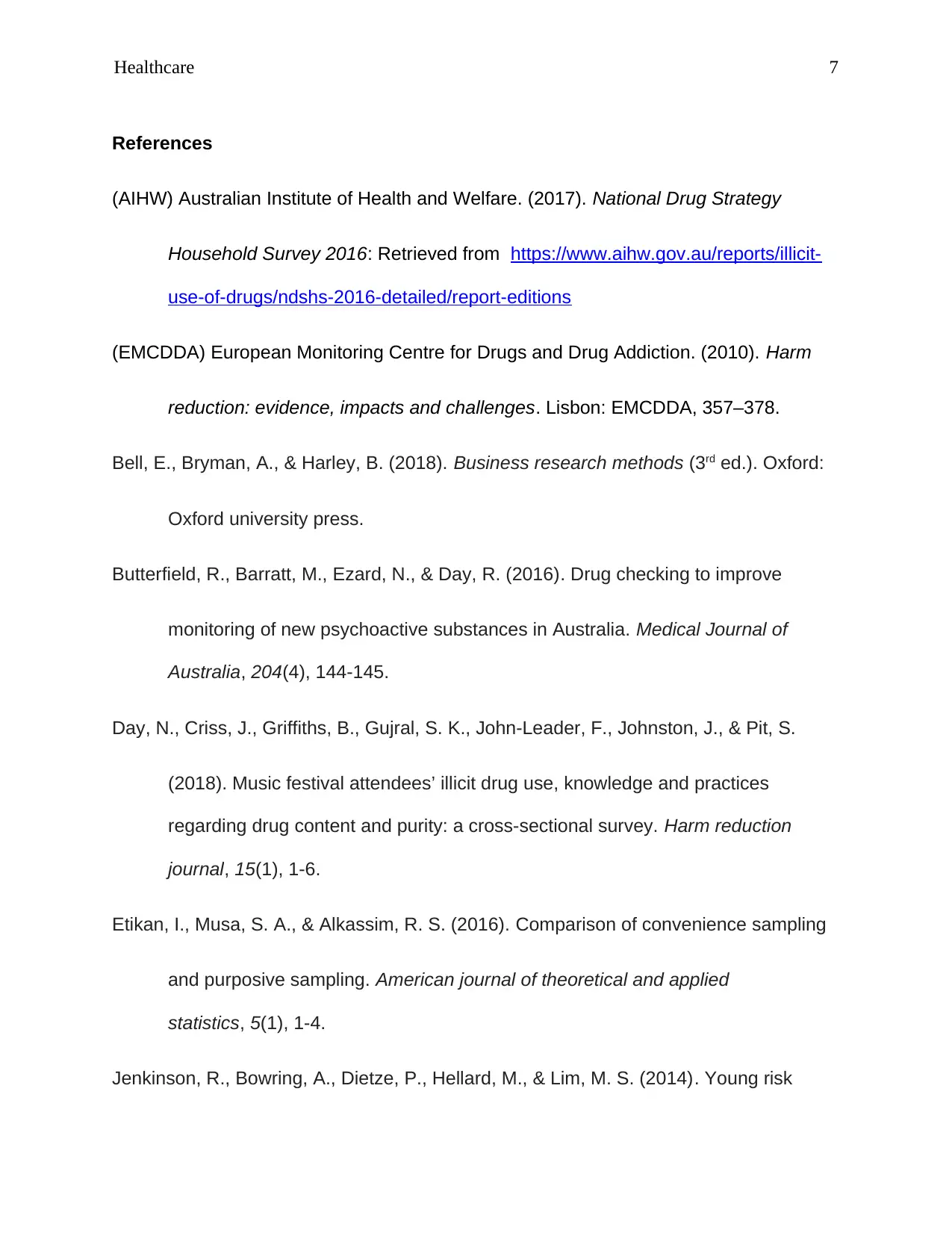
Healthcare 7
References
(AIHW) Australian Institute of Health and Welfare. (2017). National Drug Strategy
Household Survey 2016: Retrieved from https://www.aihw.gov.au/reports/illicit-
use-of-drugs/ndshs-2016-detailed/report-editions
(EMCDDA) European Monitoring Centre for Drugs and Drug Addiction. (2010). Harm
reduction: evidence, impacts and challenges. Lisbon: EMCDDA, 357–378.
Bell, E., Bryman, A., & Harley, B. (2018). Business research methods (3rd ed.). Oxford:
Oxford university press.
Butterfield, R., Barratt, M., Ezard, N., & Day, R. (2016). Drug checking to improve
monitoring of new psychoactive substances in Australia. Medical Journal of
Australia, 204(4), 144-145.
Day, N., Criss, J., Griffiths, B., Gujral, S. K., John-Leader, F., Johnston, J., & Pit, S.
(2018). Music festival attendees’ illicit drug use, knowledge and practices
regarding drug content and purity: a cross-sectional survey. Harm reduction
journal, 15(1), 1-6.
Etikan, I., Musa, S. A., & Alkassim, R. S. (2016). Comparison of convenience sampling
and purposive sampling. American journal of theoretical and applied
statistics, 5(1), 1-4.
Jenkinson, R., Bowring, A., Dietze, P., Hellard, M., & Lim, M. S. (2014). Young risk
References
(AIHW) Australian Institute of Health and Welfare. (2017). National Drug Strategy
Household Survey 2016: Retrieved from https://www.aihw.gov.au/reports/illicit-
use-of-drugs/ndshs-2016-detailed/report-editions
(EMCDDA) European Monitoring Centre for Drugs and Drug Addiction. (2010). Harm
reduction: evidence, impacts and challenges. Lisbon: EMCDDA, 357–378.
Bell, E., Bryman, A., & Harley, B. (2018). Business research methods (3rd ed.). Oxford:
Oxford university press.
Butterfield, R., Barratt, M., Ezard, N., & Day, R. (2016). Drug checking to improve
monitoring of new psychoactive substances in Australia. Medical Journal of
Australia, 204(4), 144-145.
Day, N., Criss, J., Griffiths, B., Gujral, S. K., John-Leader, F., Johnston, J., & Pit, S.
(2018). Music festival attendees’ illicit drug use, knowledge and practices
regarding drug content and purity: a cross-sectional survey. Harm reduction
journal, 15(1), 1-6.
Etikan, I., Musa, S. A., & Alkassim, R. S. (2016). Comparison of convenience sampling
and purposive sampling. American journal of theoretical and applied
statistics, 5(1), 1-4.
Jenkinson, R., Bowring, A., Dietze, P., Hellard, M., & Lim, M. S. (2014). Young risk
Paraphrase This Document
Need a fresh take? Get an instant paraphrase of this document with our AI Paraphraser
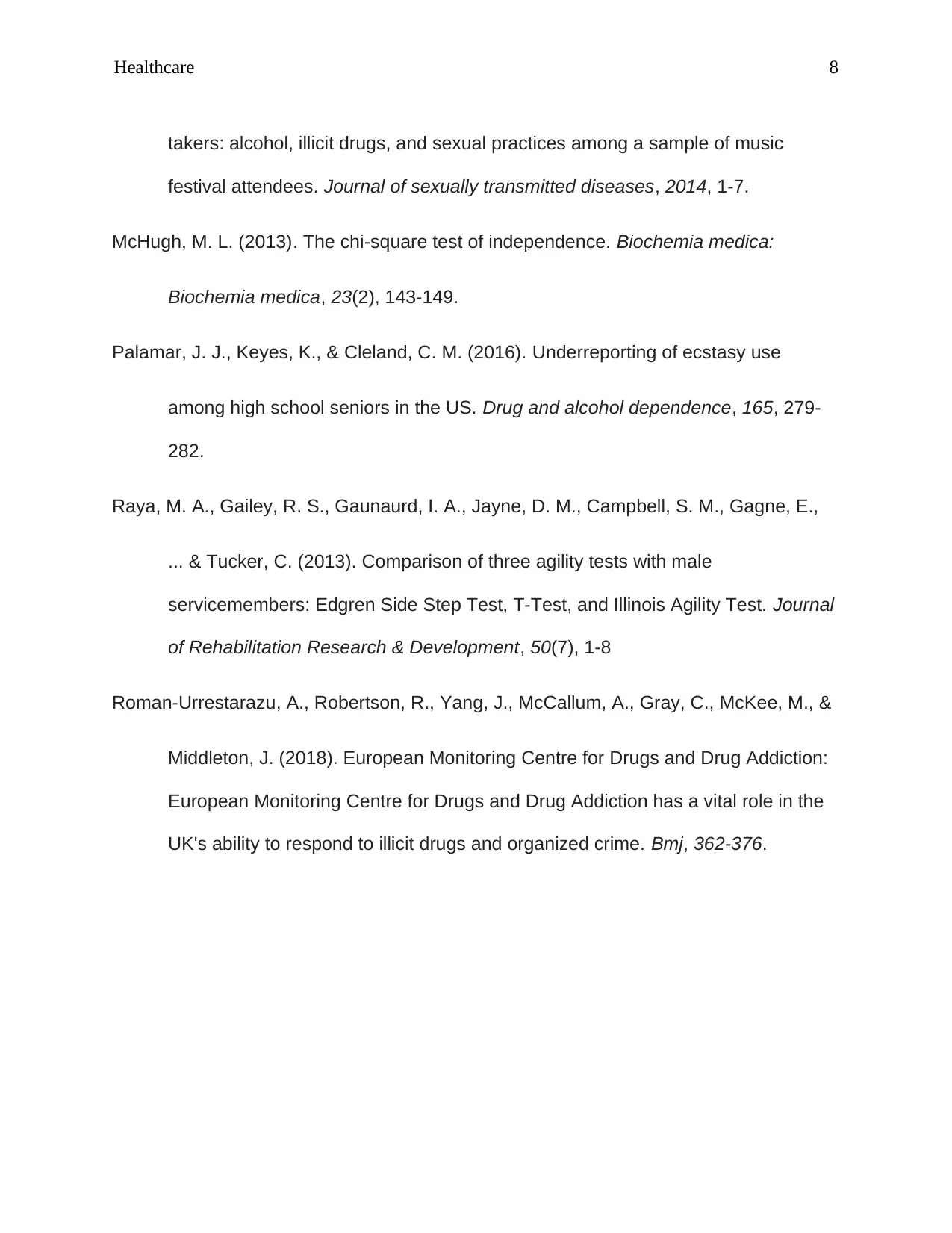
Healthcare 8
takers: alcohol, illicit drugs, and sexual practices among a sample of music
festival attendees. Journal of sexually transmitted diseases, 2014, 1-7.
McHugh, M. L. (2013). The chi-square test of independence. Biochemia medica:
Biochemia medica, 23(2), 143-149.
Palamar, J. J., Keyes, K., & Cleland, C. M. (2016). Underreporting of ecstasy use
among high school seniors in the US. Drug and alcohol dependence, 165, 279-
282.
Raya, M. A., Gailey, R. S., Gaunaurd, I. A., Jayne, D. M., Campbell, S. M., Gagne, E.,
... & Tucker, C. (2013). Comparison of three agility tests with male
servicemembers: Edgren Side Step Test, T-Test, and Illinois Agility Test. Journal
of Rehabilitation Research & Development, 50(7), 1-8
Roman-Urrestarazu, A., Robertson, R., Yang, J., McCallum, A., Gray, C., McKee, M., &
Middleton, J. (2018). European Monitoring Centre for Drugs and Drug Addiction:
European Monitoring Centre for Drugs and Drug Addiction has a vital role in the
UK's ability to respond to illicit drugs and organized crime. Bmj, 362-376.
takers: alcohol, illicit drugs, and sexual practices among a sample of music
festival attendees. Journal of sexually transmitted diseases, 2014, 1-7.
McHugh, M. L. (2013). The chi-square test of independence. Biochemia medica:
Biochemia medica, 23(2), 143-149.
Palamar, J. J., Keyes, K., & Cleland, C. M. (2016). Underreporting of ecstasy use
among high school seniors in the US. Drug and alcohol dependence, 165, 279-
282.
Raya, M. A., Gailey, R. S., Gaunaurd, I. A., Jayne, D. M., Campbell, S. M., Gagne, E.,
... & Tucker, C. (2013). Comparison of three agility tests with male
servicemembers: Edgren Side Step Test, T-Test, and Illinois Agility Test. Journal
of Rehabilitation Research & Development, 50(7), 1-8
Roman-Urrestarazu, A., Robertson, R., Yang, J., McCallum, A., Gray, C., McKee, M., &
Middleton, J. (2018). European Monitoring Centre for Drugs and Drug Addiction:
European Monitoring Centre for Drugs and Drug Addiction has a vital role in the
UK's ability to respond to illicit drugs and organized crime. Bmj, 362-376.
1 out of 8
Related Documents
Your All-in-One AI-Powered Toolkit for Academic Success.
+13062052269
info@desklib.com
Available 24*7 on WhatsApp / Email
![[object Object]](/_next/static/media/star-bottom.7253800d.svg)
Unlock your academic potential
Copyright © 2020–2025 A2Z Services. All Rights Reserved. Developed and managed by ZUCOL.





